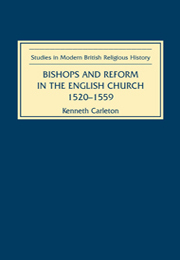Book contents
- Frontmatter
- Contents
- List of Illustrations
- Dedication
- List of Abbreviations
- Acknowledgements
- Introduction
- 1 Theologies of Episcopacy in mid-Tudor England
- 2 Models of Episcopal Office
- 3 Bishops of the English Church, 1520–1559
- 4 The Bishop and Preaching
- 5 Bishops and the Provision of Education
- 6 Prayer and Sacrifice: the Life of the Bishop
- 7 Episcopal Activity I: the Eradication of Heresy
- 8 Episcopal Activity II: the Propagation of the Ministry
- 9 Conclusion: the Old Episcopate in a New Order
- Appendix I Prosopography of the bishops in office, 1520–1559
- Appendix II The dioceses
- Appendix III The education of the bishops
- Appendix IV The bishops of Sodor and Man
- Bibliography
- Index of Scriptural References
- General Index
8 - Episcopal Activity II: the Propagation of the Ministry
Published online by Cambridge University Press: 12 September 2012
- Frontmatter
- Contents
- List of Illustrations
- Dedication
- List of Abbreviations
- Acknowledgements
- Introduction
- 1 Theologies of Episcopacy in mid-Tudor England
- 2 Models of Episcopal Office
- 3 Bishops of the English Church, 1520–1559
- 4 The Bishop and Preaching
- 5 Bishops and the Provision of Education
- 6 Prayer and Sacrifice: the Life of the Bishop
- 7 Episcopal Activity I: the Eradication of Heresy
- 8 Episcopal Activity II: the Propagation of the Ministry
- 9 Conclusion: the Old Episcopate in a New Order
- Appendix I Prosopography of the bishops in office, 1520–1559
- Appendix II The dioceses
- Appendix III The education of the bishops
- Appendix IV The bishops of Sodor and Man
- Bibliography
- Index of Scriptural References
- General Index
Summary
From the earliest times, bishops in the Church have set apart others to share in their ministry of oversight and pastoral care. In the consecration of new bishops they ensured the continuation of their office, while the ordination of suitable candidates to the priesthood, diaconate and other ministries in the Church ensured that sacramental functions and pastoral care were available to the laity at large. Such ordinations were carried out by the diocesan bishop, or by another bishop acting with his authority and by his permission. The ordination of candidates to the minor orders, and on occasions to the subdiaconate, could be delegated to a priest not in episcopal orders, often the abbot or prior to whom the candidates, members of religious orders, were subject. Towards the end of the Middle Ages the holding of ordinations was more usually delegated by the diocesan to other bishops. Other specifically episcopal actions, such as holding confirmations, dedicating and consecrating churches, chapels and churchyards, and the reconsecration of ecclesiastical property following its desecration through bloodshed or pollution, were very frequently carried out by others than the diocesan. The consecration of bishops, on the other hand, was almost invariably carried out by the metropolitan of the province (in the English Church the archbishops of Canterbury and York), with at least two co-consecrators in accordance with the ancient tradition that at least three bishops should share in this action.
- Type
- Chapter
- Information
- Bishops and Reform in the English Church, 1520–1559 , pp. 156 - 178Publisher: Boydell & BrewerPrint publication year: 2001



